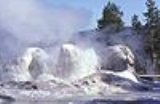
Grotto Geyser
Encyclopedia
Grotto Geyser is a fountain-type geyser located in the Upper Geyser Basin in Yellowstone National Park
in the United States
. Grotto Geyser is the namesake for the group of geysers that includes Grotto Fountain Geyser, South Grotto Fountain Geyser, Indicator Spring, Spa Geyser, and Rocket Geyser.
entered the Upper Geyser Basin where in a day and a half of exploration, they named seven geysers of which Grotto was one. Nathaniel P. Langford
described the Grotto in his 1871 Scribner's account:
, one of the world's most powerful geysers. Giant erupts only during so-called "hot periods," times of intensified activity and rising water among the smaller geysers surrounding Giant. Most hot periods do not lead to Giant eruptions, but Giant eruptions frequently start during the hot period immediately following the start of a Grotto eruption. Additionally, the long, "marathon" eruptions of Grotto are commonly followed, a few hours after they end, by a particularly intense "recovery hot period" in the Giant complex that may instigate a Giant eruption. Giant eruptions may also occur 4 to 5 hours after the start of a Grotto marathon eruption.
Yellowstone National Park
Yellowstone National Park, established by the U.S. Congress and signed into law by President Ulysses S. Grant on March 1, 1872, is a national park located primarily in the U.S. state of Wyoming, although it also extends into Montana and Idaho...
in the United States
United States
The United States of America is a federal constitutional republic comprising fifty states and a federal district...
. Grotto Geyser is the namesake for the group of geysers that includes Grotto Fountain Geyser, South Grotto Fountain Geyser, Indicator Spring, Spa Geyser, and Rocket Geyser.
History
On September 18, 1870 members of the Washburn-Langford-Doane ExpeditionWashburn-Langford-Doane Expedition
The Washburn Expedition of 1870, explored the region of northwestern Wyoming that a couple years later became Yellowstone National Park. Led by Henry Washburn, Nathaniel P. Langford and under U.S. Army escort led by Lt. Gustavus C...
entered the Upper Geyser Basin where in a day and a half of exploration, they named seven geysers of which Grotto was one. Nathaniel P. Langford
Nathaniel P. Langford
Nathaniel Pitt Langford was an explorer, businessman, bureaucrat, vigilante and historian from St. Paul, Minnesota who played an important role in the early years of the Montana gold fields, territorial government and the creation of Yellowstone National Park.-Montana Gold Fields:On June 16, 1862...
described the Grotto in his 1871 Scribner's account:
"The Grotto" was so named from its singular crater of vitrified sinter, full of large, sinuous apertures. Through one of these, on our first visit, one of our company crawled to the discharging orifice; and when, a few hours afterwards,
he saw a volume of boiling water, four feet in diameter, shooting through, it to the height of sixty feet, and a scalding stream of two hundred inches flowing from the aperture he had entered a short time before, he concluded he had narrowly escaped being summarily cooked. The discharge of this geyser continued for nearly half an hour.
Eruptions
Grotto Geyser erupts about every eight hours. The interval between eruptions is longer after a longer eruption. The eruptions are about 10 feet (3 m) high and can last from about 1 hour to more than 10 hours long, although there have been eruptions that lasted more than 26 hours.Sequence
Grotto Geyser's eruptions are usually preceded by an eruption from Grotto Fountain Geyser. After it has a short mode eruption, which lasts about 1 to 2 hours, Rocket Geyser usually has a major eruption. Approximately three-quarters of Grotto's eruptions are short mode. Grotto Geyser and Rocket Geyser erupt together. When Grotto Geyser has a long mode eruption, which lasts from 6 to 12 hours, Spa Geyser, instead of Rocket Geyser, erupts.Interactions
Grotto is significant beyond its own considerable size because of the interactions between its own eruptions and those of nearby Giant GeyserGiant Geyser
Giant Geyser is a cone-type geyser in the Upper Geyser Basin of Yellowstone National Park in the United States. Giant Geyser is the namesake for the Giant Group of geysers, which includes Bijou Geyser, Giant Geyser, Giantess Geyser and Mastiff Geyser. Giant Geyser is also the namesake for the Giant...
, one of the world's most powerful geysers. Giant erupts only during so-called "hot periods," times of intensified activity and rising water among the smaller geysers surrounding Giant. Most hot periods do not lead to Giant eruptions, but Giant eruptions frequently start during the hot period immediately following the start of a Grotto eruption. Additionally, the long, "marathon" eruptions of Grotto are commonly followed, a few hours after they end, by a particularly intense "recovery hot period" in the Giant complex that may instigate a Giant eruption. Giant eruptions may also occur 4 to 5 hours after the start of a Grotto marathon eruption.

